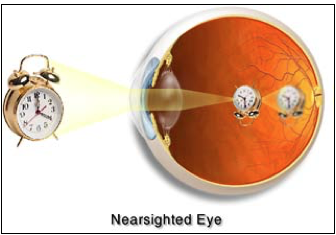Myopia (short-sightedness or near-sightedness)

When light rays enter the eye, they should normally be focused on the central fixation point (macula) of the eye in order for the eye to produce clear vision.
In a myopic eye, the eye is too long for light rays to be focused accurately on the macula. Images are formed in front of the macula instead, resulting in blurred vision. In myopic people, distance vision is blurred unless they wear visual aids like glasses or contact lenses. Glasses or contact lenses re-direct light rays entering the eye so that they focus accurately on the macula, producing clear vision.
High myopia is more than just having to wear thick glasses. Highly myopic eyes are more likely to develop serious complications like retinal tears, retinal detachments and early macular degeneration (myopic degeneration) which can result in blindness. They are also more likely to develop glaucoma, early cataracts and floaters. This is because of structural abnormalities in myopic eyes.
 LASIK surgery can be done to reduce the myopic “power error” so that vision can be clear without the use of glasses or contact lenses. However, even after myopia has been removed by LASIK, the eye remains prone to the complications mentioned above because LASIK only corrects the “power error” but does not rectify the structural problems with highly myopic eyes.
LASIK surgery can be done to reduce the myopic “power error” so that vision can be clear without the use of glasses or contact lenses. However, even after myopia has been removed by LASIK, the eye remains prone to the complications mentioned above because LASIK only corrects the “power error” but does not rectify the structural problems with highly myopic eyes.
Myopia (together with astigmatism and presbyopia) can also be corrected by modern cataract surgery in which the cataractous lens is replaced by advanced technology lens implants.
Myopia is an extremely common eye disorder in Asians, especially myopia in Singapore, but myopia in young children can now be controlled with Atropine eye drops.
